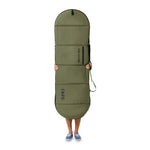
Surfboards are built for waves, travel, and endless sunny sessions, but over time many surfers notice an unwelcome change—their once bright, glossy board begins to turn yellow. This discoloration can make a board look old and neglected, even if it still rides perfectly. For collectors, hobbyists, and surfers alike, understanding why this happens is key to keeping a board looking its best. FARO, known for crafting durable surf accessories and protective board bags, emphasizes that proper care and storage play a big role in slowing down this process.
So, why do surfboards turn yellow? The answer lies in a combination of environmental exposure, material science, and how you care for your board. This guide explores the causes of yellowing, the science behind it, and what you can do to prevent or minimize the effect.
UV Radiation and Its Impact
One of the most common reasons surfboards turn yellow is prolonged exposure to sunlight. Surfboards are typically made with fiberglass and resin, both of which are sensitive to UV radiation. When exposed to the sun, UV rays break down the chemical bonds within the resin. This process slowly degrades the clear finish, creating a yellow tint.
-
Geography plays a role: Boards stored or ridden in sunny areas like Hawaii, California, or Australia are more likely to yellow quickly than those used in cloudier regions such as England or the Pacific Northwest.
-
Constant exposure matters: Leaving your surfboard on the beach or strapped to the roof of your car in the sun accelerates the yellowing process.
Preventing UV-Related Yellowing
-
Use surfboard bags with UV-resistant linings to block direct sunlight.
-
When storing your board at home, keep it in a cool, shaded area rather than outdoors or in a hot garage.
-
Choose boards made with UV-stabilized resin, which naturally resists discoloration longer.
Even small changes in storage habits can make a noticeable difference in how your surfboard ages.
Oxygen Exposure and Oxidation
Even without direct sunlight, surfboards can yellow. This happens because of oxidation, a natural process where oxygen in the air reacts with the resin on your board. Over time, oxidation alters the resin’s clarity, giving it a faded, yellow tone.
-
Oxidation doesn’t require sunlight: A surfboard stored indoors but exposed to air can still yellow.
-
Collector boards are at risk: Vintage boards that sit unused in garages often develop a deep yellow or brownish tint due to years of oxidation.
Preventing Oxidation
-
Store boards in sealed surfboard bags or even air-tight containers if they are collector’s items.
-
Regularly wax and clean your board to create a protective layer between the resin and oxygen exposure.
-
Avoid leaving your board uncovered for long periods when not in use.
Oxidation is slow but inevitable, which is why prevention methods are essential for anyone wanting to preserve their surfboard’s bright white look.
Impact of Water Quality
Saltwater is another factor that accelerates yellowing. When surfboards are used in the ocean, salt crystals can work their way into the resin, weakening it and making it more prone to discoloration. Additionally, polluted water containing oil, algae, or chemicals can also leave behind stains that contribute to the yellow effect.
-
Saltwater accelerates wear: Boards used in tropical regions with high salt concentrations often show signs of yellowing faster.
-
Freshwater is gentler: While rivers and lakes don’t contain salt, they may still carry pollutants that stain boards over time.
Preventing Water Damage
-
Always rinse your board with fresh water after every session.
-
Dry it thoroughly before storing to avoid salt or mineral buildup.
-
Use a protective bag during transport to limit exposure to ocean spray.
This simple rinse-and-store habit is one of the most effective ways to reduce yellowing while also extending the lifespan of your surfboard.

Ways to Prevent or Minimize Yellowing
Yellowing is part of a surfboard’s natural aging process, but it doesn’t have to happen quickly. With the right care, you can delay discoloration and keep your board looking sharp.
UV-Protective Coatings
Special coatings and sprays are available to add an extra layer of UV protection. These work much like sunscreen for your board, slowing down the breakdown of resin polymers caused by the sun.
Proper Storage Practices
Storing your surfboard properly is one of the most important steps:
-
Keep boards out of direct sunlight.
-
Avoid hot, humid storage areas like car trunks.
-
Store them flat or upright in padded racks to reduce stress on the resin and structure.
Choosing UV-Stabilized Resins
If you are purchasing a new surfboard, ask about the resin. Many manufacturers now use resins with UV stabilizers, which significantly improve a board’s ability to resist yellowing.
Regular Cleaning and Waxing
Keeping your surfboard clean prevents buildup of contaminants that can accelerate yellowing. Waxing also provides a small degree of protection by shielding resin from direct exposure.
Investing in a FARO Surfboard Bag
A surfboard bag is one of the most effective preventive tools. FARO’s eco-friendly canvas surfboard bags are designed with UV-resistant coatings and durable materials. These bags not only protect against sunlight but also reduce the risk of scratches, dings, and environmental wear. For surfers who care about performance and aesthetics, a high-quality bag is a worthwhile investment.
Removing Yellowing from Surfboards
Even with the best prevention methods, some yellowing is inevitable over time. The good news is that there are both DIY and professional methods to help reduce or restore a surfboard’s appearance.
Home Remedies
Some surfers attempt to lighten yellowed boards using household solutions. While results vary, these methods may restore part of the original brightness:
-
Baking soda paste: Applied and left to sit before rinsing.
-
Vinegar solution: Used as a wipe-down to break down surface stains.
-
Hydrogen peroxide spray: Left on for several hours to lift discoloration.
These approaches are inexpensive but only partially effective, and they may not restore the board to a pure white finish.

Professional Restoration
For serious discoloration, professional surfboard restoration services are the most reliable option. Techniques often include:
-
Sanding the surface to remove the discolored resin layer.
-
Re-glassing with fresh resin to restore clarity and strength.
While more costly, this process can return an older surfboard to near-new appearance, making it ideal for collectors or long-term board owners.
Risks of DIY vs. Professional Methods
DIY remedies carry the risk of damaging the resin or weakening the board if not done carefully. Professional services, while more effective, may slightly alter the board’s dimensions or weight due to the additional resin layer. Surfers should weigh these risks before deciding which approach to take.
Final Thoughts
Surfboard yellowing is a natural part of owning and riding boards, but it does not have to happen quickly or go unaddressed. By understanding the causes—UV radiation, oxidation, water exposure, and contaminants—you can take proactive steps to slow down discoloration.
The best defense is prevention. Regular rinsing, careful storage, UV-resistant resins, and protective surfboard bags, like those from FARO, are all simple strategies that make a big





